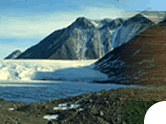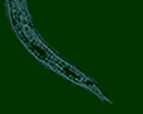Global Litter Invertebrate
Decomposition Experiment
Pálava
Biosphere Reserve in South Moravia, Czech Republic
Site Manager
Dr.
Josef Rusek
Institute of Soil Biology
Academy of Sciences
Na sadkach 7
370 05 Ceske Budejovice
Czech Republic
Telephone: (+420) 38 7775747
Fax: (+420) 38 5300133
Site Description
This GLIDE site is located at the southernmost part of Moravia,
Czech Republic, near the boundaries with Austria and Slovakia.
The Pavlovské Hills with the highest hill D_vín
(554 m above sea level) represents the westernmost part of
the Carpathian mountains. They are built up by limestone.
The lower part of the protected area is formed by Tertiary
and Holocene sediments with well developed lowland riparian
forests. Pavlovské Hills belong to the most xerothermous
territories of the Czech Republic and they belong to the
westernmost part of the Danubian and Pannonian Planes. Warm
and dry climate on the Pavlovské Hills and humid condition
in the floodplain forests influenced the highly diverse vegetation
and animal communities. The Pavlovské Hills belong
to the botanically and zoologically best known areas in the
Czech Republic and have a long research history. The forest
communities of the Pavlovské Hills was studied by
Horák (1969), Rozko_n_ and Va_hara (1995a, b, 1996)
summarized all data on the very rich invertebrates of the
Pálava Biosphere Reserve. Also soil biological research
was and is done in this extremely interesting area (Pi_l
1998, Rusek 1984, Tajovsk_ 1998).
Site Location
Site location is in the Czech Republic, South Moravia,
16°37’- 16° 59’E and 48° 37’-
48° 53’N. Three ecologically contrasting subsites
were used for the GLIDE experiment:
Subsite 1
Xerothermic deciduous forest Corneto-Quercetum on the foot of the south slope
of the D_vín Hill, 340- 360 m above sea level.
Subsite 2
Riparian forest Fraxino pannonicae-Ulmetum at K_ivé jezero National
Nature Reserve, about 3 km southeast of the D_vín Hill and 200 m northwest
of Pansk_ ml_n, 170 m above sea level.
Subsite 3
Riparian forest Fraxino pannonicae-Ulmetum (less wet than Subsite 2) at K_ivé jezero
National Nature Reserve, about 2 kmsoutheast of the D_vín Hill and 500
m north of Subsite 2, 172 m above sea level.
Site
Area
Site area is 83 kilometers squared.
Site
Elevation
Site elevation 170-554 m above sea level.
Annual Rainfall
Annual rainfall is 524 mm.
Annual Temperature
Annual temperature is 9.6° C.
Soil
Soil type is renzina soil with mull-like moder on limestone
and alluvial soil in riparian forests.
Subsite 1: Soil type is renzina soil with mull-like moder humus form, on limestone.
Subsite 2: Soil type is alluvial soil (fluvisoil) with controlled spring floods.
Subsite 3: Soil type is alluvial soil (fluvisoil) with controlled spring floods.
Native
Forest/Vegetation Types
Native vegetation are xerothermic grasslands, xerothermic
deciduous forests on limestone, and riparian forests along
the Dyje river.
Principal Biome/Ecoregion
Principal biome is temperate deciduous forest.
References
Horák J.(1969) Waldtypen
der Pavlovské kopce (Pollauer Berge).
Acta Sci. Nat. Acad.Sci. Bohemoslovacae Brno, 3 (7): 1-40.
Pi_l V. (1998) Earthworm communities in Pálava Biosphere Reserve (Southern
Moravia) with special reference to the impact of floods. In: Pi_l V. & Tajovsk_
K. (eds) Soil Zoological Problems in Central Europe. Inst. Soil Biol., _eské Bud_jovice,
pp. 157-166.
Rozko_n_ R. and Va_hara J. (1995a) Terrestrial invertebrates
of the Pálava
Biosphere Reserve of UNESCO. I. Folia Fac. SCI Univ. Masarykianae Brunensis,
Biologia, 92: 1-206.
Rozko_n_ R. and Va_hara J. (1995b) Terrestrial invertebrates
of the Pálava
Biosphere Reserve of UNESCO. II. Folia Fac. SCI Univ. Masarykianae Brunensis,
Biologia, 93: 215-406.
Rozko_n_ R. and Va_hara J.(1996) Terrestrial invertebrates
of the Pálava
Biosphere Reserve of UNESCO. III.
Folia Fac. SCI Univ. Masarykianae Brunensis, Biologia, 94: 415- 630.
Rusek J. (1984) Zur Bodenfauna in drei Typen von _berschwemmungswiesen
in S_d-Mähren.
Rozpravy _eskoslovenské Akademie V_d, _ada matematick_ch a p_írodních
V_d, Academia Praha, 94 (3): 1-126.
Tajovsk_ K. (1998) Diversity of terrestrial isopods (Oniscidea) in flooded
and nonflooded ecosystems of Southern Moravia, Czech Republic. Israel J. Zool.,
44: 311-322.
Photo Gallery
|







